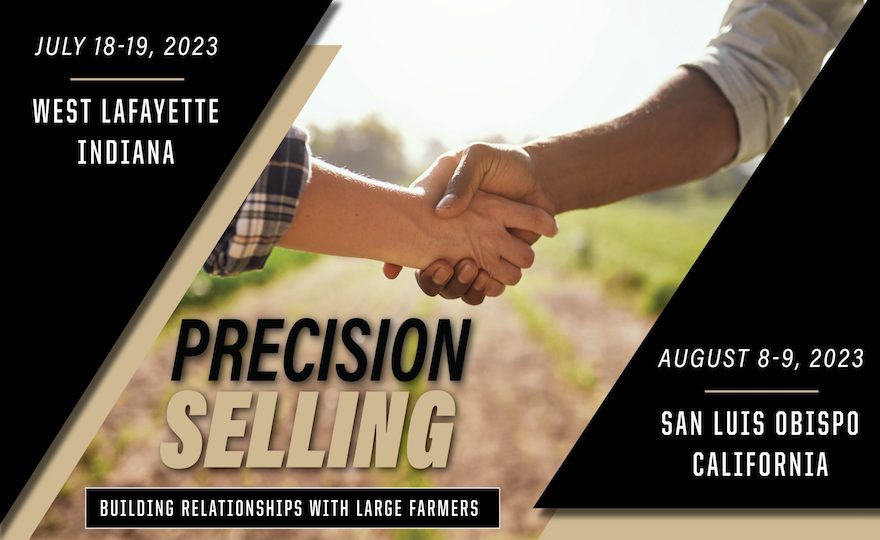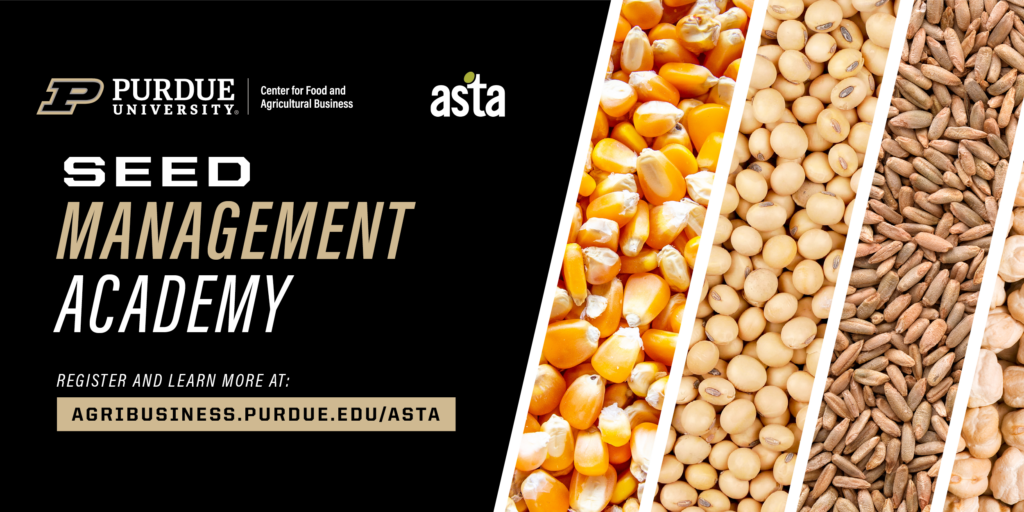Author: Dr. Scott Downey, Director and Professor
As you’re probably aware, our focus here at the Center for Food and Agricultural Business (CAB) is, and always has been, on companies who serve farms and ranches. The core of this focus has been on sales interactions; agriselling is in our DNA (for me, quite literally, given that I followed in my father’s footsteps).
About twenty years ago, early in my Center career, consolidation was a very hot topic. It was changing the process of selling. With fewer, more demanding farmers and ranchers, salespeople were really needing to sharpen their tools. At the same time, the idea of precision agriculture was catching hold. Producers were realizing inputs are scarce and expensive, so farms and ranches needed to be more precise in where they were used. Those times seem so much simpler now. Little did we realize production agriculture would continue to be driven by really big factors — consolidation, yes, but also consumer interest in sustainability and regenerative agriculture, and even scarcer resources, in part from more extreme risks from weather, unstable markets and supply chains, and technology. Precision Selling – putting scarce sales resources where they are most needed in order to maximize the sales return – has never been more critical.
Today, nearly every organization trains people on basic sales skills and most salespeople are good at selling. Salespeople MUST be good at sales to survive. However, Precision Selling is about more than basic sales skills — prospecting, handling objections, and closing. Although the execution of these skills can be difficult, they aren’t particularly challenging concepts to understand. The complexity of producing food, fuel, and fiber across North America has driven Precision Sellers to develop three areas of expertise in order to sell goods and services in agriculture with precision: Customization, Strategy, and Relationships. These three areas are often honed by experience, but I believe anyone can improve in these areas by using tools, and maybe most importantly, young sellers can develop these areas to grow quickly in their abilities.
1. Customization. Sometimes when we’re in the thick of things, it’s hard to step back and see changes. Sales used to be like baseball. Salespeople would memorize a “pitch” and make it repeatedly. Sales was a numbers game. Get to the plate enough times and you’ll get your hits. Objections were like strikes. You had to keep swinging in order to connect. Sales ability was a gift, and the process to refine it was tied to repetition. Today, with fewer customers and more obstacles, the sales process has to be unique to each buyer. If we make the same pitch to every customer, we’re just a walking advertisement. Today’s buyers are sophisticated. If the message isn’t tailored to them, based on how they produce a crop or animal, they’ll ignore it.
2. Strategy. Sticking with the baseball theme, sales is much more like the movie, “Moneyball” than “Field of Dreams” or “Bad News Bears” (and I know I’m dating myself with those references). It’s not enough just to be good; we’ve also got to be smart. Actually, we’ve even moved past Moneyball. Being strategic means we can’t just make decisions based on opinion, but we shouldn’t ignore experience either. Data by itself is worthless. Data and thinking together lead to the best possible outcomes. Thinking without data is just OPINION. Strategy is about being intentional, measuring what’s important. There’s not a ROI for measuring everything, but you can’t measure nothing.
Combining the ideas of customization and strategy means we need to use tools where they make sense. We don’t have to have a formal plan for every sales call, but we better know how to make a good plan and do it for our most important sales calls. We don’t need a strategy for selling every customer, but we better know how to create one and do that for our most important customer opportunities.WHAT we measure in our strategic decisions is also important. The idea of leading and lagging metrics drives the ways we teach sales today. For the last 100 years, sales were managed almost entirely on lagging metrics – the outcomes. Revenue or unit sales, even market share, margins, and share of wallet are examples. The primary data used for those metrics is the result of a process (compared to some other number in the case of market share, margin, and share of wallet). The problem is that you can’t do anything about an outcome. If you want to change the outcome, you have to change the inputs to it. So, today, we focus more on the factors that LEAD to the sale – leading metrics. Like quality of sales call, sales activities on targeted accounts and depth of customer knowledge. In other words, improving on the factors that drive sales leads to higher sales.
3. Relationships. Some people are surprised by this one, as relationship selling seems a little old school. But here we’re not talking about social relationships, we’re talking about business relationships. Social relationships are still important, but knowing the name of the dog on that ranch isn’t going to get you a sale today. Relationships are about trust. They’re about knowing what’s relevant to each member of a decision team, and taking them ideas they will find useful. Relationships aren’t about solutions, they’re about working together to discover innovations – co-creating value. Business relationships aren’t about being the last phone call when a buyer is shopping for something; business relationships are about getting a call when they are even considering something new for their business.
In many ways, a business relationship is separate from the transaction. For the buyer, a business relationship is a risk management tool. Of course, they buy when they have a strong business relationship, but the transaction is almost an afterthought from the customer perspective. The book, The Challenger Sale, is getting a little dated now, but when it first came out, some people misinterpreted the message as saying salespeople should challenge their customers. That characterization totally missed the point. Instead, the message is high performing salespeople build the types of relationships that are not dependent only on the transaction – they leverage trust into conversations about customer’s goals such that there can be meaningful discussion as partners rather than as hunter and prey.
Precision Selling: Building Relationships with Large Farmers has consistently been one of the most popular offerings from the Center. Although traditionally delivered in West Lafayette, the program has never solely focused on Midwest agriculture and people from across the country have participated. However, after been asked for many years to regionalize and customize the approach to unique areas of production, for the first time ever there will be a program geared toward western US agriculture! With the same content and regional examples, Precision Selling will be delivered August 8-9, 2023 in San Luis Obispo! There is also still time to register for the July 18-19, 2023 program on Purdue University’s West Lafayette campus!




